Michelle Barker's Blog: Hearing Voices, page 4
June 6, 2021
Writer in Training: The Triple Clown
It was the perfect storm, literally.
One of us hadn’t brought enough food.
One of us hadn’t brought enough clothes.
And one of us thought it would be fine to ride the mountains even though they were shrouded in clouds.
We’re hoping to do the triple crown in a few weeks, so we’ve been climbing as often as we can, usually doubling up on the mountains so we can experience their full nastiness.
For anyone who doesn’t know, the triple crown is a traditional Vancouver ride that involves climbing Seymour, Grouse, and Cypress—usually in that order. All told, with getting there and getting home, it works out to about 130km and 2600m in elevation.
In order for it to be a true triple crown, you have to start at the bottom of each mountain. Skipping those climbs—particularly the one to Cypress—is considered cheating.
I did the ride for the first time last year. It was gruelling but immensely satisfying. Now I’m hooked.
But when it comes to training for it, there are a few necessities:
Obviously, work a lot of climbing into your training. This is not a ride you can wing. And ideally, climb the mountains—over and over. Get familiar with them. They’re hard. You need to know what you’re up against.Bring a lot of food and hydration. Even though there are places to stop along the way, you don’t want to run out of either.Bring extra clothes for the descents. No matter the season, it’s going to be cold coming down.Pace yourself. There’ll always be that person who starts the ride with a bang, flying up Seymour. Chances are you’ll meet up with them somewhere around the Cypress first lookout, having burned all their matches and unable to continue.Check the weather in both North and West Vancouver. 30% chance of rain is too high. You don’t want any rain. Trust me on that.But back to this weekend’s disastrous ride…
Our ascent up Grouse was chilly but fine. We were even fine at the first lookout at Cypress. There was blue sky; it was all good.

By the time we reached the top of Cypress, it was getting colder. Two hikers passed us saying, “Feels like winter.” Yeah. In our bike shorts it certainly did.
We bundled up as best we could and began the descent.
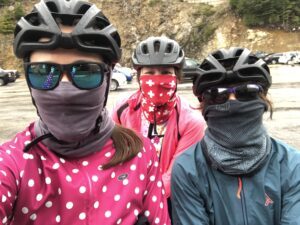
Then it started raining.
Then it started pouring.
Then it started pouring so hard we could barely see.
The ride down was slow and scary, and by the time we reached the bottom we were shivering and unable to continue.
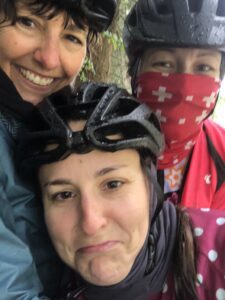
Thank God for generous Uber drivers with Escalades. We fit all three bikes into the back and, despite our being soaked and disgusting, the driver didn’t mind having us in his car.
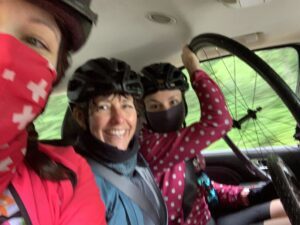
It’s a funny story in retrospect, but we learned some hard lessons for the big ride ahead—which naturally has been rechristened the Triple Clown.
May 31, 2021
Writer in Training: Training in Uncertainty
 Training is officially underway for Ironman 2021…or is it? Some days I’m convinced the race can’t possibly go ahead. Part of me thinks, Thank God, because I’m not ready. Though another part thinks, Come on already, Covid, I’m not getting any younger. Who knows how many more Ironmans (Ironmen?) I have in me? And in truth, I’ll never feel ready. I don’t think anyone does.
Training is officially underway for Ironman 2021…or is it? Some days I’m convinced the race can’t possibly go ahead. Part of me thinks, Thank God, because I’m not ready. Though another part thinks, Come on already, Covid, I’m not getting any younger. Who knows how many more Ironmans (Ironmen?) I have in me? And in truth, I’ll never feel ready. I don’t think anyone does.
I guess one of the things we’re training for these days is an acceptance of uncertainty. Regardless of the control we think we have over life, uncertainty is the norm. Of course, it always has been, but until last year, it was easy to pretend otherwise. I’m uncomfortable with that; I don’t like it. But that doesn’t change the truth of it. If I’ve learned anything from the pandemic, it’s that we never know what’s going to happen, and we shouldn’t take anything for granted.
When it comes to Ironman, I’ve decided the only safe way to proceed is to assume the race will go ahead and train accordingly. The alternative—to not train and then find out, surprise, here comes race day—is too awful to consider.
This plan hasn’t been without its complications. Swimming has been a battle this year—that’s a topic for a separate post—and while I’d like to think I’m making progress, I’m still a long way from where I need to be. It used to be the one event of the three I was quite certain I could manage without mishap. That is no longer the case. As it stands now, it will be a miracle if I can finish the 4k in an hour and half.
And running? Last year, when there was nothing on the line, I was running 20-25k every Sunday without any issue. Running was going so well…until it wasn’t. Suddenly, my old friend Achilles came to visit, and then I broke my toe but kept on running because I’m me, and then that foot developed compensation issues, and then…yeah. What else is new?
I’m afraid to mention cycling out of pure superstition, so I just won’t say anything about it.
Will I really be sad if Bonnie Henry decides Ironman can’t go ahead? No. It will feel like a reprieve, but I have a feeling that reprieve isn’t coming and it’s time to start penciling in some longer distances on my calendar.
“Stop thinking of it as a problem,” my son says. “Think of it as an opportunity.”
Ironman has a way of opening doors to what at first seems impossible; it also has a way of cutting people’s expectations down to size. And even though these two things sound mutually exclusive, the race (in my experience) manages to do both.
“So it takes thirteen hours,” a friend said. “Or it takes seventeen. Who cares? Just do it.”
No expectations, because what’s the point? So. Here I am. Let’s do this. (Maybe).
January 19, 2021
Writer in Training: The Trouble With Planning

Over the past few months I’ve come to realize that planning is a double-edged sword. It’s great to make a training plan for an upcoming race—but the plan has to be fluid. As a novelist, I should know this. I depend on the outline I make for a novel, but I’m always ready to change it if the story or the characters demand it.
The same is true for training plans, though this has taken me longer to learn. They’re great in theory, but they cannot (and must not) take the place of intuition.
Every single time I’ve made or followed a training plan, I’ve gotten myself into trouble. My problem is that I’m very good at following a plan. Too good. If it’s on the plan, I do it—no hesitation, no questions asked.
But it seems when I have a plan, it takes over everything, and I stop listening to my body. Numbers take hold of me. Deadlines loom. I start worrying that if I don’t do exactly what’s on the plan, I won’t get there in time. And then I don’t listen when something in my body complains that I’ve gone too far or too fast, and of course… I end up paying the price.
Turns out it’s no coincidence that the best training I ever did was this past year when there were no races and I threw out my plan. I had some goals, but they were always tentative. Mostly I trained by feel. If I felt like running 25K on a Sunday, I did it. If I didn’t feel quite up to that, I did less. There was no judgment involved; I didn’t feel good or bad about what I did. I listened to my body. There was no pressure to go faster or do more, because it didn’t matter. The only thing that mattered was doing what I believed my body could handle and stopping when it was right to stop.
And then races crept back in (or the idea of them, because who are we kidding? There are no races yet). And suddenly there I was with my calendar, putting in the numbers and following them blindly. The only smart thing I’ve done so far is to use a pencil rather than a pen.
Nothing can take the place of body awareness. It’s the most important part of this process. If something doesn’t feel right, you have to stop. A looming race does not mean you should do more distance than you’re ready for or push harder on your speed. That’s a recipe for disaster. But it’s a disaster I seem to fall prey to time and again.
This past year, that didn’t happen, but I didn’t understand why until this very morning—and it took a friend to point it out to me. It wasn’t because I’d trained less. In fact, in 2020 I rode and ran almost 1,000KM more (in each sport) than I had during the previous year when I’d been training for the Ironman—and with zero injuries. The thing was, there was no pressure to do more than my body could handle. So I never did.

These were filled in AFTER I’d done them, not before.
There’s a huge lesson in this. I only hope I manage to remember it long enough to spare me from the next injury. In the meantime, I’ve buried my marathon training plan in a pile of papers on my desk.
January 12, 2021
Writer in Training: The Things I’ve Learned About Running
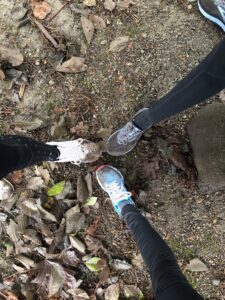
So…I thought I’d start the year off by forgetting everything I’ve ever learned about running and instead doing too much speed work in one week and upping my mileage at the same time, just so I could totally ruin my Sunday long run and have to walk home while my run buddies enjoyed a 20K run by the ocean on a gloriously sunny winter day.
Yeah.
With that in mind, I’ve decided to make a list of the things I’ve learned and maybe post it somewhere where I’ll see it regularly so that I don’t forget. If it helps anybody else, so much the better.
Here it is, in no particular order.
Keep track of the miles you run in a particular pair of shoes, and buy new ones more often than you’d think. 500K is the limit I’ve been told; less if they’re ASICS. Really, if you start getting little niggles in your feet and/or calves and it’s not because of a lack of strength or mobilization, you probably need new shoes.A sports bra should not see its first birthday. If you’re having chafing issues, invest in a new one and make sure it fits tight. You’re welcome.Drink little to no coffee before a run. If you don’t know why, well, just try drinking too much. Then you’ll know why.Bring food. Most people are not as weird about this as I am, but I won’t leave the house without some food in my pocket. Half the time I don’t even eat it, but I know it’s there if I need it. I’ve already written about the 80/20 rule of training, but it’s worth reminding myself: if you want to be fast, go slow 80% of the time. There is not a lot of wiggle room in this. 80% really does mean 80%.And that other 20%? Go to track. Work hard. It will pay off.You’ll think you can get by without strength training, and maybe you can…for a while. But sooner or later it will catch up to you. Do yourself a favour: start now, and do it regularly. It’s an investment you won’t regret.Don’t neglect your feet. Foot strength might sound dumb, but it’s essential and it will save you a lot of grief over time.Change only one thing at a time. Whether that’s speed, or mileage, or a different type of workout. One. Thing. At. A. Time.And speaking of mileage: a gradual increase per week is the rule. And by gradual I also mean small. How small seems to be up for debate, but I find a 5-10% increase is safe. Anything more is pushing it.Listen to your body. If there’s a problem, stop before it gets bad. Don’t pretend it isn’t there when you know it is.Schedule in regular down weeks. Yes, you need them.Drink more water. Every year I promise myself I’m going to do this and then I don’t.I’m sure I’ve forgotten things. If anyone has any wisdom to share, please add it in the comments. I’d love to hear about it.
I started the new year doing something dumb (not really a surprise if you know me). I’ve since made a sweeping declaration to my running partner that I will not do anything dumb in running for the rest of the year. Outside of running I cannot make that promise.
January 1, 2021
Writer in Training: Now’s the Time

About fifteen years ago, a well-meaning physiotherapist informed me that my lower back issues were so severe I would probably never run again. At the time, I believed her.
This past year, I logged 1,748KM of running.
Of course, there’s more to this story. My journey to being able to run again included a steep learning curve, a lot of injuries, and countless hours of physiotherapy, massage, and strength training to correct a lifetime’s worth of asymmetries and compensations. It still includes those things. Most of my runs begin with an hour of strength training and end with stretching and a warm bath.
Maybe for some people that’s too high a price to pay to be able to run consistently. For me, it’s worth every second of effort. My runs are the highlight of my week. They have also become a proud middle finger to anyone who tells me I can’t do something.
Running is my thing. It might not be yours. Still, you probably have something in your life that you’ve always dreamed of doing but, for whatever reason, haven’t done it. The bottom line? If you really want to do something—if you’re willing to pay whatever price is demanded of you—you can.
We’ve finally turned the corner on a very tough year, and all of us are hopeful 2021 will be better. Maybe your only New Year’s resolution is to keep your head above water—and that’s fair enough. But we create our own bright spots in life. If there’s something you’ve always wanted to do but thought (or were told) you couldn’t do it, maybe this is the year you stop listening to the naysayers (including that voice in your head) and give it a try.
It might not work right away. You might discover there are ten hoops you have to jump through before you can do the thing, whatever it is. Your devotion will likely be tested. You’ll have to start small and go slow. But who cares? If it’s something you’ve always wanted, it will be worth the time and effort it takes to get there.
2020 has changed people in many ways. It’s made us realize what’s important in our lives—and what isn’t. What’s worth fighting for; and what needs to change. Now’s the time to make a decision and do that thing, whatever it is.
Don’t let anyone tell you you can’t, or you’re too old, or it’s too hard, or you don’t have what it takes. Life is unpredictable, as we’ve learned this year. Prove them wrong, whoever they are, and do it.
December 9, 2020
Writer in Training: Long Slow Me
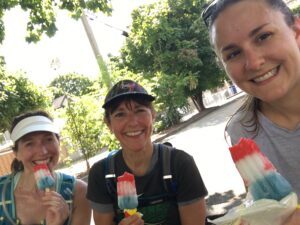
All summer runs should end with popsicles
Last year, on November fourth, I woke up with one of those ideas that pokes and prods until you have no choice but to say, yes, okay already, I’ll do it. I decided I wanted to run the BMO Marathon.
But there was more to it than that. As many of you might know, I have had a complicated relationship with running over the years. I love it more than anything, but I’ve never been able to do it for long without injuring myself. My mantra has always been: go hard or go home. So I’d go hard, hurt myself, and then have to take time off to recover.
I decided that would not be my strategy for this marathon. No matter how humiliating it would be on Strava, no matter how many people would be amazed that a person could run that slowly and still actually be moving, I was going to train for this marathon without getting injured. Which meant: long SLOW runs.
This is not a revolutionary idea. And it’s not like I didn’t know slow training was the proper way to do the long run. I’d been to a lecture by Golden Harper the year before where he’d explained it all very clearly. I took notes. But I’d never been willing to try it. Slow running seemed so boring. And it’s counter-intuitive: how do you get faster if all you ever do is run slowly?
Well, you don’t. You can’t ONLY run slowly. Besides the weekend long runs, I also started attending track night to do speed work. The secret is in the ratio of slow to fast. Matt Fitzgerald wrote a book about it called 80/20 Running, which I highly recommend. And yes, that’s the ratio: 80% of your workouts should be slow (Zone 1-2). Only 20% should be fast (Zone 4-5). Notice the absence of Zone 3? Zone 3 is the junk zone, the place where you work harder than you should for absolutely no gain and a high risk of injury.
I basically lived in Zone 3 for years. It explains a lot.
Luckily I found a partner in this project—another runner who, like me, had suffered constant injury from running too fast for too long. We made a pact: we would train for this marathon as slowly as we needed to, and we would finish it without getting injured.
And then 2020 happened…
and the BMO was canceled.
In all honesty, it might have been a silver lining. One of the other things I discovered this year was just how long it takes to build a solid base of running. I don’t know if I would have been ready to run a marathon last May. It might have produced the injury I was trying so hard to avoid.
Instead, when the marathon was canceled, we stopped building miles but kept on running. And the months passed, and we got faster…and we did not get injured.
Now, this requires some explanation. Both of us have had to learn to be proactive and listen to our bodies. To back off when an ache becomes a little too persistent, BEFORE it turns into an injury. This might sound easy, but don’t be fooled. Yesterday I started a Zwift workout and had to force myself off the bike after fifteen minutes because of a niggle in my quad that I had noticed on Sunday’s long run. Zone 3 Me would have muscled through and ended up limping for the rest of the day. Long Slow Me looked at today’s scheduled run and decided, nope, I’m going to play it by ear. Any pain and I go home.
It’s been a learning process, and as we try to put together a new marathon program and I continue to make bone-headed training mistakes, I still feel like I’m in preschool.
But on the whole, the plan is working. I have never, in my whole life, been able to run consistently like this without serious injury. And in the end, that was what I really wanted. The win is in the process. The race—if it happens next year—will be a bonus.
If it doesn’t, we’ll just keep running.
September 1, 2020
Writer in Training: Pretend a Bear is Chasing You

I remember the first spin class I ever went to. To make us work harder, the instructor suggested we pretend a bear was chasing us. I was with my daughter. We looked at each other and rolled our eyes. As if THAT would ever happen.
Since then, I’ve had several encounters with wildlife while on my bike. I have never actually been chased on land (different story in the water). But I have passed several bears by the side of the road while riding and have had to make a number of quick about-faces to avoid the spin class instructor’s scenario.
Not so bad to pretend a bear is chasing you when you’re going downhill. But oddly, every time I’ve met up with a bear, I’ve been climbing. If the bear in question was hungry, she wouldn’t even have to break a sweat. It would be more like the Callaghan Buffet. Stroll up, grab an appetizer off the bike, bring it home for the cubs.
Late this spring I decided to climb Cypress. I’d never ridden past the second lookout, and with cars banned from the route early in the pandemic, I figured it was the ideal time to go.
However, no cars meant no noise, and no noise meant the bears roamed free, especially early in the morning—which is my preferred time to ride. As I made my way up an almost deserted road, two cyclists came flying down the hill toward me. They slowed as they drew closer.
“Bears,” they said. Plural.
“Did you have to turn around?” I asked.
“Yes. They’re right beside the road.”
I hesitated. When I make up my mind to do something, it takes a lot to make me turn around. The cyclists said the bears were near the second lookout, and I still had a ways to go before I got there. Maybe by the time I arrived, they’d be gone.
I kept riding.
They weren’t gone.
Reluctantly I turned around, but I wasn’t happy with the arrangement.
I rode about a kilometer down when, to my surprise, the two cyclists had returned, and this time they’d brought friends. A posse. Huh. I turned around and followed them back up. The bears were still there, but the other cyclists managed to scare them away and we made it to the top without being chased. Mischief managed.
However, I was not so lucky in the water.
I’ve always been a brave open-water swimmer because, as some of you might know, I like to live in denial. Denial works for me. Nothing will get me, or bother me, or chase me, because stuff like that only happens to other people.
The thing with denial is, it doesn’t stand up well to reality.
One rainy morning, my son and I went for an early morning open-water swim at Jericho. The water was calm. The beach was empty.
“There might be seals,” he said with a note of fear in his voice. “Two of them. They seem to live here, like it’s their territory.”
I started laughing. “So what? Seals are cute.”
He lifted an eyebrow.
“Don’t worry,” I said. “I’ll protect you.”
We swam out to the far buoy, stopped to check on each other, and he said, “Look. Over there.”
A little black head popped out of the water. It was a seal.
“Are you scared?” I said. And then I started talking to the seal. Hi sweetie, how are you, in the voice people use with babies and pets. It was my first mistake.
My son didn’t want to swim long, so he decided to get out and get changed. I kept swimming. I was now the only one in the water.
Or so I thought.
I swam all the way to the far side and turned around, intending to do another lap, when I felt something bump up against my feet.
Anyone who swims open water knows how the imagination can play tricks on you. You can feel seaweed and creatures and a whole host of creepies if you let yourself think about it. It’s even worse when you’re alone. So I got it under control and thought, nope, just my imagination, and pushed it out of my head.
Except then it happened again.
I swim with an orange floating Swim Buddy that hangs from a strap at my waist, so my next thought was, my feet must have touched the floaty. Except the floaty didn’t reach my feet, and the thing, whatever it was, didn’t feel like a floaty. It was hard, and cold, and it pushed against me as if it had a mind of its own.
Because it did. It was the seal.
As soon as I realized that, I had a moment of pure panic completely out of proportion to the situation. To watch me swim to shore, you would have thought I was being chased by a Great White. But there’s no accounting for terror, and when that seal kept coming back and banging itself against my feet, I swam for my life.
I was only thankful no one was on the beach to watch, because as I walked onto shore and looked behind me, that little black head popped up out of the water and I swear the damn thing was laughing at me.
In retrospect, swimming alone is probably not the best idea. If anything serious was to happen, a floating Swim Buddy wouldn’t be much of a substitute for an actual person.
And…note to Coach Stewart: “Pretend a seal is chasing you” would work for time trials. Just saying.
August 26, 2020
Writer in Training: Surfacing
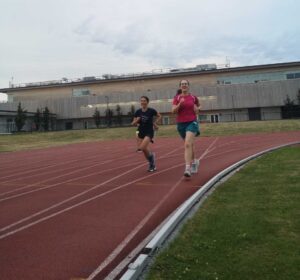
Track night: the best night of the week; photos and coaching: Katie Couture
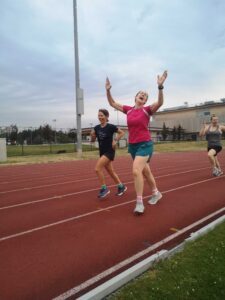
It’s been a long time since I’ve posted anything, and really I have no good excuse. I suppose the lack of races has taken away that building momentum I’m always bugging my novel-writing clients about. I’ve been in more of a holding pattern during the pandemic, but it has been an interesting and instructive time:
I’ve learned how to run without injuring myself
I’ve realized that, for me, triathlon is at least as much about lifestyle as it is about racing
I’ve discovered that swimming is not my favourite thing, but it is a good thing and I need to do more of it
I’ve had a few close encounters with wildlife
I’ve explored new routes and knocked some epic rides off my bucket list.
I could say a lot about each one of these things, but I’d like to talk about lifestyle, especially since racing doesn’t seem to be coming back anytime soon.
One thing about races is that they provide ready-made goals and motivation. They give you a deadline. They impose structure. Take that away, and you’re bound to start asking some tough questions about what you’re doing and why. Do you really like this sport? Would you do it for its own sake and not because there are spectators and results and age-group rankings? (Of course, who are we fooling? There’s still Strava.)
It can be hard to impose this motivation on yourself, though I think it can be done. How you do it probably depends a lot on your personality. If you’re socially motivated, setting a run date with someone in your bubble might be the way to keep you moving. If you’re goal-oriented, deciding what you want and planning your way to get it will also work. And if it turns out you don’t care about triathlon as much as you thought, maybe it’s time to explore other options.
I spend a significant part of my day sitting at a desk, so riding and running (and swimming, okay, yes) provide an essential means of escape. They clear my head and give me a restart button after half my day is over and I can’t sit or think or write anymore. They’re also an essential mood-lifter. Endorphins are my drug of choice, and I confess a full dependence on them.
So, I’ve discovered that this triathlon lifestyle suits me very well. As someone funnier than I am once said: why be good at one sport when you can be average at three? But I like the variety. I love running, but I know I can’t do it every day without hurting myself, so I need other options. I like the way biking takes me places I wouldn’t otherwise go and makes me a better runner, and swimming… what does swimming do again? Kidding. Swimming is essential for keeping my back healthy and my body aligned. This lifestyle works for me, and I’ll keep doing it regardless of what happens to racing.
Which brings me to racing.
I’m doing fine without it. Setting goals seems to work: choosing things to achieve that are important to me—not for any particular reason, but just because striving is a way to improve, and measuring that striving is a way to confirm that you are improving. My running partner and I have set some fall goals, and we’re going to sit down sometime soon with a calendar and my right-now-favourite running book and figure out how to reach them. My speedy daughter has agreed to pace us, which will make a huge difference. It’s amazing how much faster you can run when you’re trying to keep up with someone.
Ironman Canada was supposed to be on Sunday. Of course I wish we were all in Penticton doing the race. But I have hope that racing will come back, and even if it doesn’t happen in the near future, I’ll keep setting goals and working hard to achieve them.
Next up: the bears on Cypress, and that seal.
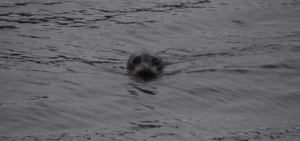
April 28, 2020
April 4, 2020
Wearing Sweatpants to the Apocalypse: April 4th
 April second was supposed to be the date of my Vancouver book launch, a time to gather with friends and family and celebrate the culmination of years of hard work. Obviously that didn’t happen.
April second was supposed to be the date of my Vancouver book launch, a time to gather with friends and family and celebrate the culmination of years of hard work. Obviously that didn’t happen.
For my last book launch, I ordered the books late and then spent several sleepless nights worried they wouldn’t arrive on time. This year I decided to be organized and ordered them well in advance. Suddenly I found myself facing isolation with fifty copies of the same book.
When I mentioned my situation on Facebook and asked if anyone wanted me to send them a book, the response was overwhelming. I am so grateful to everyone who reached out.
Anyone with the misfortune to be launching a book right now knows how wrong this whole situation feels—like we’ve dropped our work down a hole and are watching it get smaller and smaller until it disappears. Publishers are doing everything they can, and I’d like to believe more people are reading while they’re stuck indoors—but I suspect the Netflix numbers tell a different story.
I’m busy writing a new novel, and every day I sit down to work on it feels like a vote of hope for the future, because—what is the future of publishing? Most of the biggest publishers are in New York City. How many new books will they be taking a chance on in the coming year? And some of the smallest publishers were barely surviving before the pandemic hit. Will they still exist? How about independent bookstores?
My daughter has adopted a wonderful practice in Toronto: twice a week she chooses a small restaurant that is still open for delivery and makes a point of ordering dinner from them to support them. I have started doing the same here in Vancouver.
It occurs to me this practice could also be applied to books, authors, and independent bookstores.
If you want books to still be a thing in our post-pandemic world, please: buy them. And maybe see if you can buy them from independent booksellers, because Amazon will be just fine, thank you.
Here are some links to writers I know whose work is coming out right now (including the opening photo which I couldn’t find a link to, but if you’re interested, just contact me and I’ll arrange to get you a copy). Look them up: they’re all great. Tell your friends.
https://www.regalhousepublishing.com/product/grace/
https://www.harpercollins.ca/9781443459181/five-little-indians/
http://jollyfishpress.com/product/rewritten/
http://www.mothertonguepublishing.com/page22/2019-new-books.html
http://redtuquebooks.com/patti-shales-lefkos-nepal-one-day-at-a-time/
And here is a link to Canadian independent booksellers who will deliver.
What better way to spend these weeks of isolation than with a bunch of good books?
Hearing Voices
This is a blog for writers and readers who love to hear voices. ...more
- Michelle Barker's profile
- 61 followers





